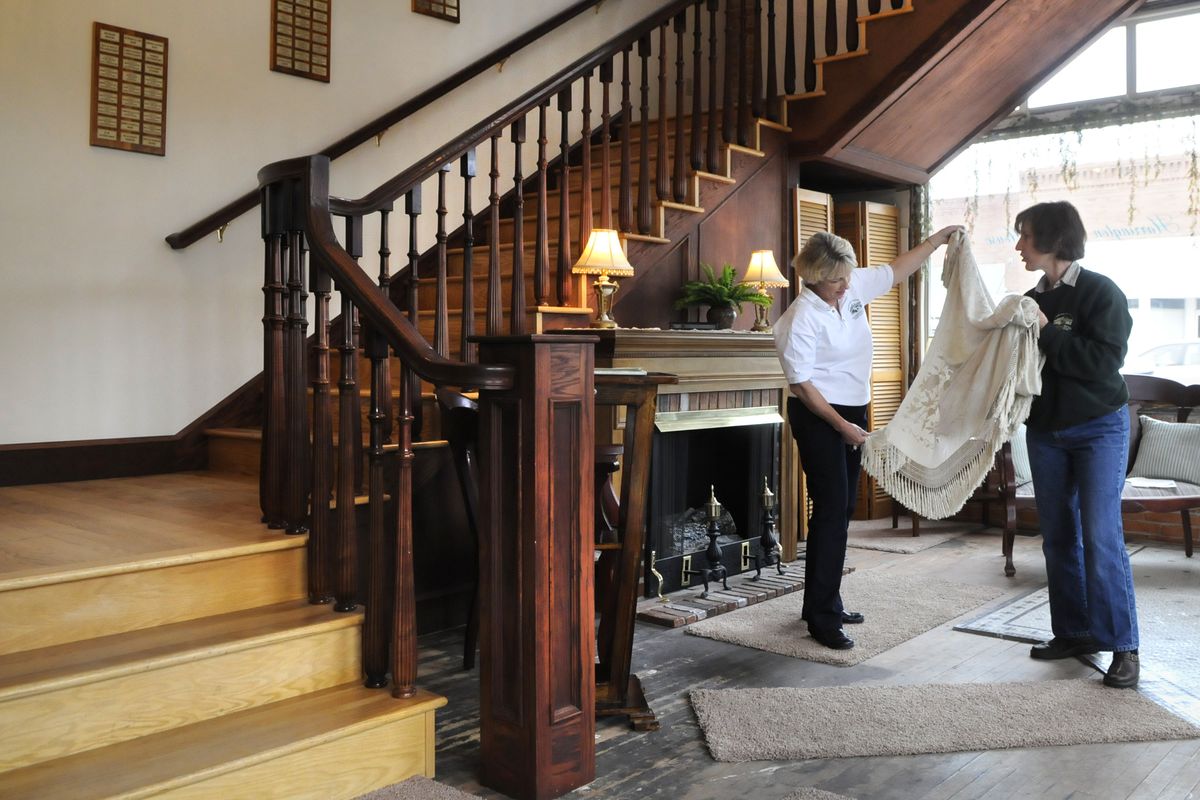Residents work tirelessly to restore Opera House to former glory

• The Lady Minstrels launching the brand new auditorium in 1904 with the “swellest home entertainment ever seen in this city.”
• The long-ago incident that prompted someone to scrawl the following graffiti on a dressing room wall: “Cut out the booze or leave the hall” (details sadly lost to posterity).
• The time the entire crowd at a town dance joyfully performed the Bunny Hop, causing the building’s foundations to shift alarmingly. In 1954, the Opera House was abandoned after everyone decided the building was simply getting too scary.
• The time a folk group, the Soda Creek Three, discovered that they were being circled by a squadron of bats – so they smoothly segued into “Ghost Riders in the Sky.” (This occurred just before the building got a fine new metal roof in 1999.)
However, those stories pale beside the best story of all: the story of how the people in this small town have worked tirelessly to restore the Harrington Opera House.
In 1992, this once grand brick edifice was roofless, bat-filled, unheated and dangerously askew. Today, the 283-person-capacity Harrington Opera House is clean, bright, secure and home to jazz concerts, folk concerts, lectures, weddings, recitals and high school dances. This year, the guitar-woodwind duo Tingstad and Rumbel performed a St. Patrick’s Day concert, the Ritzville Community Theatre staged an original comedy and the Coulee Community Choir sang a program of hymns.
“We are the cultural center of Lincoln County,” said Billie Herron, one of those tireless citizens.
It was built in 1904, when Harrington was more than twice as big as today and the surrounding countryside was filled with farmers and farmhands who needed entertainment on Saturday nights.
A local firm built the big brick building and installed the Bank of Harrington on the main floor, along with the town newspaper, a barbershop/bathhouse, a cigar store and a basement bowling alley. The upper story was the grand hall, “the opera house,” so named because the word “opera” had more respectable connotations than the somewhat bawdy “theater.”
Usually the hall hosted local shows and town dances. A dusty young farmhand could deposit his wages, get a shave, take his weekly bath and then go upstairs to a dance (and sometimes “there was more going out in the alley than in the dance,” wistfully recalled one old-timer).
Yet the region, the town and the hall hit some rough times during the Great Depression. Also, mechanization drastically reduced the need for farmhands. By World War II, the old hall was showing signs of disrepair, and by 1954 the building became too dilapidated to use regularly.
It sat vacant for decades. Then in 1992 a group of Harrington citizens realized that the old landmark would either have to be rescued or torn down. Some of the roof was gone, the walls had settled as much as five inches, and dry rot had set in. They formed the Harrington Opera House Society and began raising money.
They sold T-shirts and had bake sales – and more importantly they began to apply for, and win, some grants. By 1999, they had enough money to accomplish the most urgent goal: to put a new metal roof on the building. The days of bats and pigeons flying around the stage were over.
Yet they still had a massive job in front of them. The place needed new plumbing, new wiring, new lights, new heating, new seats and a new method of ingress and egress to supplement the one big staircase. With such an overwhelming to-do list, it would have been easy simply to do nothing. Gordon and Billie Herron, longtime Harrington Opera House Society members, decided it was time to make a choice.
“Gordy got tired of attending meetings where nothing happens,” said Billie Herron. “We decided, ‘We’ll jump in with both feet or drop out.’ ”
They chose the former. They and dozens of other key members, including Ed and Bunny Haugan, Margaret Kupers, current society president Linda Wagner and webmaster Karen Robertson, went to work. Sometimes, it involved hard manual labor, including jacking up the walls so that the building was plumb once again.
Even more crucially, the work included sitting down and writing grants. So far, the society has garnered an impressive $335,000. Big grants came through from the Inland Northwest Community Foundation, the Joel E. Ferris Foundation, US Bank, Wheatland Bank, the state, the Avista Foundation and Lincoln County.
The members of the society also consulted with other small towns that have pulled off similar restoration miracles – notably Metaline Falls with its amazing Cutter Theatre – to get tips on how to proceed.
Since then, the Harrington Opera House Society has achieved the following:
• A new and safer staircase.
• New wiring.
• A new heating system.
• New chandelier-style lights.
• New plumbing.
• New ceilings.
• New seating, in the form of wooden pews donated by Harrington Community Church.
Some big tasks still remain, including installing air conditioning and restoring the proscenium stage. Yet they’re confident it will get done. The community support, from all over Lincoln County, has been especially gratifying for the society members.
“At the beginning people were saying, ‘It’s no good, tear it down,’ ” said Gordon Herron. “But now, those people are our strongest supporters. They’re excited when they come here and see what they see.”
What they see is a clean, well-lit hall usable for concerts, Humanities Washington presentations, art shows, community events, high school dances and weddings.
“One of the most exciting things to me is that the schools are starting to use it for their concerts,” said Billie Herron, who is a piano teacher. “It’s exciting for me, as a musician, for the students to experience what it’s like to perform in a real theater environment.”
A real theater environment – how many little wheat towns can boast that?